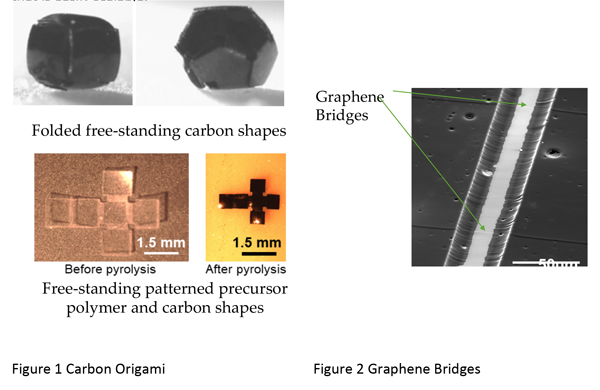CBE Seminar (ZOOM): Controlling Micro and Nano Carbons for 3D Shape, Microstructure and Function

Chancellor's Professor
Department of Mechanical and Aerospace Engineering
Departments of Biomedical Engineering, and Chemical & Biomolecular Engineering
Abstract: Over the last two decades, we have gained more and more insight into how to convert patterned polymer precursors into predicable 3D carbon shapes by pyrolysis/carbonization (see Figure 1 carbon origami for a recent example). Over the last four years, we have started gaining control over the internal carbon microstructure and its functionality. The key to the latter is a precise control of the polymer precursor chains and the exact polymer atomic composition of the polymer before and during pyrolysis. Contradicting Rosalind Franklin, we have found that it is possible to graphitize even non-graphitizing carbons simply by applying mechanical stresses to align the polymer precursor chains and stabilizing them in position before pyrolysis. Perhaps the most surprising outcome of this work is the demonstration eight months ago of the conversion of PAN fibers through pyrolysis into turbostratic graphene-suspended wires with diameters as small as 2 nanometers (see Figure 2). The suspended graphene bridges have a conductivity similar to that of multiwall carbon nanotubes (MWCNTs) a Young’s modulus of > 400 GPa and electrochemically, the material behaves like graphene doped with nitrogen. The latter material represents a very electroactive electrode ideally suited for energy and sensing applications. The current fabrication process for graphene doped with nitrogen is lengthy and complicated; ours is a one-step simple process that is easily scalable.

Bio: Before joining UCI as the Chancellor’s Professor in mechanical and aerospace engineering, Marc Madou was vice president of advanced technology at Nanogen in San Diego. He specializes in the application of miniaturization technology to chemical and biological problems (BIO-MEMS). The author of several books, Madou helped pioneer this burgeoning field both in academia and in Industry. He founded several micromachining companies and has been on the board of many more.
Today, Madou works with research teams in India (IIT Kharagpur), Mexico (Tec de Monterrey), Malaysia (UM) and Germany (KIT). In the recent past, he also worked on large projects with teams in South Korea and Canada.
Madou was the founder of the SRI International’s Microsensor Department, founder and president of Teknekron Sensor Development Corp. (TSDC), visiting Miller Professor at UC Berkeley and an endowed chair at The Ohio State University, where he was a professor in chemistry and materials science and engineering. He is the author of the third edition of “Fundamentals of Microfabrication,” an introduction to MEMS and NEMS, which has become known as the “bible” of micromachining.
Madou has an h-index of 77 (as of May 14, 2020) and is considered the pioneer of two research fields that are now being pursued worldwide: carbon micro- and nanofabrication (C-MEMS and C-NEMS) and compact disc fluidics (CD-Fluidics) for molecular diagnostics. These two technologies have resulted in at least 10 startup companies worldwide. Of those founded by Madou, Enevate, a lithium ion battery company in Irvine, California, is the largest and best known.
To find out more about his most recent research projects, visit www.biomems.net.
NAI Fellow
Academia Mexicana de Ciencias
Star Faculty Tecnológico de Monterrey, Campus Monterrey Mexico
International Visiting Professor IIT Kharagpur, India
UNIST, South-Korea (World Class University Scholar, WCU)
Icon Professor University of Malaya
NAI Fellow
Share
Upcoming Events
-
CEE Ph.D. Defense Announcement: Machine Learning and Remote Sensing for Environmental Modeling - From Large-Scale Streamflow Forecasting to Malaria Risk Mapping
-
CBE Special Seminar: Operando Electrochemical Methods at Dynamic Energy Materials Interfaces
-
CEE Ph.D. Defense Announcement: Release, Transport and Fate of Per- and Polyfluoroalkyl Substances (PFAS) in Urban Watersheds
-
MSE 298 Seminar: Mechano-Electrochemical Phenomena at Ceramic Electrolyte Interfaces
-
MSE 298 Seminar: Innovation In Materials Science - An Industrial R&D Perspective
